Geochronology of the Late Cretaceous magmatism and metamorphism,Pütürge massif,Turkey
Ayşe Didem KILIÇ and Cihat ATEŞ
Department of Geological Engineering,Faculty of Engineering,Fırat University,Elazıg,Turkey
1 Introduction
Located within the southeastern Anatolia thrust belt,in between the Eastern Taurus Orogenic Belt and Arabian plates,the metamorphic Pütürge massif developed as a result of the collision between the Eurasia and Arab plates,and possibly initiated in the Early Cretaceous.Extensive studies have been carried on the geodynamic formation of the massifs (Hall,1976;Özkaya,1982;Şengör and Yilmaz,1981;Robertson and Dixon,1984;Ricoue et al.,1984;Göncüo glu and Turhan,1984;Yazgan and Chessex,1991).Among the diverse metamorphic units of different sizes on the southeastern Anatolia thrust belt,the Bitlis,Pütürge,Malatya and Keban metamorphic massifs are the most representative,and they might have settled in the region during the Early Cretaceous-Early Miocene(Yilmaz,1993).
The Pütürge metamorphic massif is possibly the western continuation of the Bitlis massif within the southeastern Anatolia thrust belt.The Bitlis metamorphic massif is similar to the Pütürge metamorphic massif due to its rock structure and location.Previous studies on the internal structure of the Pütürge metamorphic rocks are limited in comparison with the Bitlis massif (Hempton,1984;Yazgan and Chessex,1991;Erdem,1994)and currently no geochronologic work has been done to determine the age of the Pütürge massif.In this paper,we report the internal structure and element distribution of zircons,as well as40Ar/39Ar dating of metamorphic biotite,separated from the amphibolite facies metamorphic rocks within the southern branch of Neotetis,the southeastern Anatolia thrust zone.
2 Geological Setting
The Pütürge massif extends from the northeast to the southwest and is about 50km long and 300m wide and is bordered by faults (Fig.1).The Middle-Upper Eocene Maden complex covers the Pütürge massif at different localities (Yazgan and Chessex,1991).The Maden complex consists of volcanosedimentary rocks,and metamorphic rocks are thickened at the study area by the dip-slip faults.Field observation finds two foliations,i.e,mionitic foliation in the fault and thrust zones,and schistosity-gneiss foliation at the external parts.Mineral stretch lineation and shear lineation are common in rocks and folds at various scales are also observed.The first geochronologic study on the Pütürge metamorphic rocks are K/Ar dating(Yazgan,1984)and it is stated that the last metamorphism of the Pütürge massif occurred at around 500~550℃ during the Late Cretaceous-Campanian.Obduction of the ophiolite nappes in the region in the Late Cretaceous was interpreted as the possible geodynamic background for metamorphism.Yazgan and Chessex (1991 ) combined the Pütürge and the Bitlis metamorphic massifs and named the complex as the Bitlis-Pütürge metamorphic belt,and conclude that the metamorphic age of this massif is 70~75Ma.Metamorphic rocks in the Pütürge complex are widespread on the southern branch of Neotethys and the Eastern Taurus Orogenic Belt and its surroundings.The Maden Complex composes of volcanic rocks and is in fault contact with the Pütürge metamorphic rocks(Fig.1).
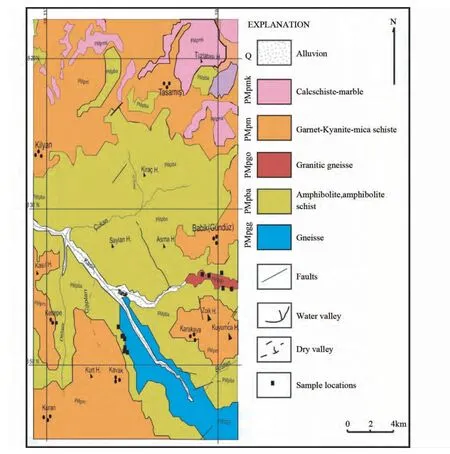
Fig.1 Geological sketch map of the study area
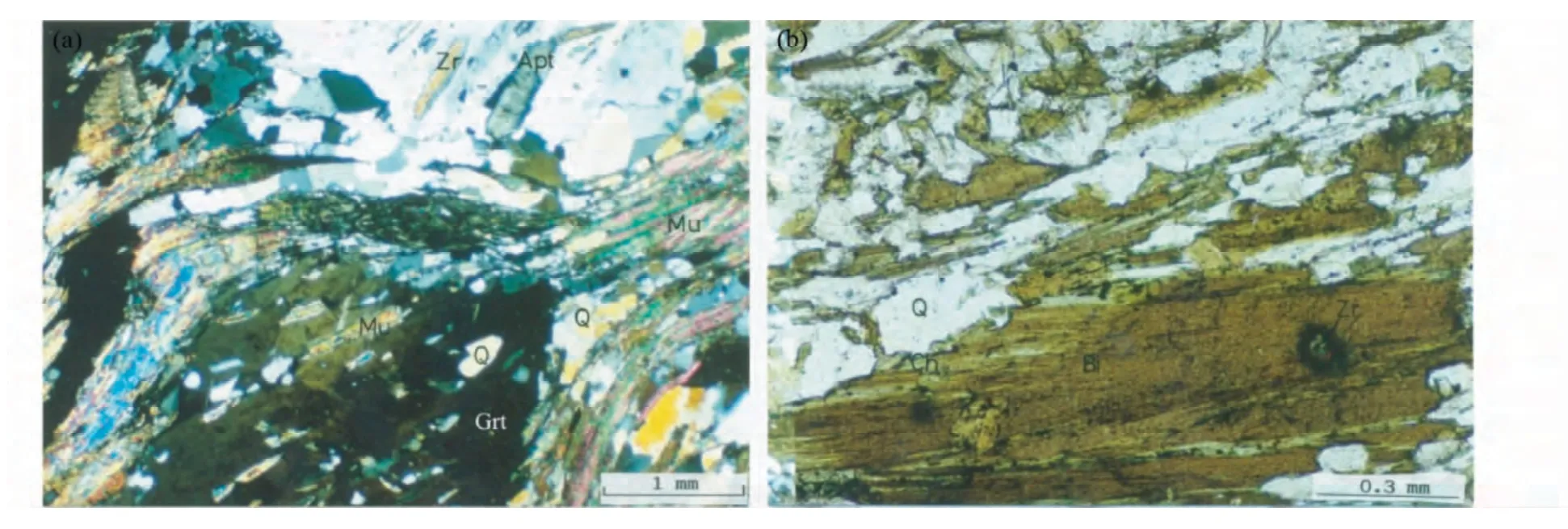
Fig.2 Micropetrographs of metapelitic gneisses of the Pütürge massif(a)metamorphic prismatic zircon crystal in the matrix,cross polarized light;(b)metamorphic zircon included in the biotite (from Erdem,94),plain polarized light.Symbols of minerals:Apt-apatite;Bi-biotite;Ch-chlorite;Gr-garnet;Mu-muscovite;Q-quartz;Zr-zircon
3 Petrography
The Pütürge metamorphic complex consists of metapelite,metasemipelite,pisamite,metagranite,amphibolite,marble and quartzite (Ateş,2011).The metamorphic rocks are classified as the follows:gneiss (quartz + feldspar + biotite + muscovite ±opaque ± apatite ± zircon ± chlorite),mica schist (quartz +feldspar+biotite + muscovite ± opaque ± apatite ± tourmaline ±sphene±zircon±epidote),garnet mica schist (quartz+feldspar+biotite+muscovite+garnet±staurolit±kyanite±sillimanite±opaque±apatite±sphene±zircon ±chlorite),calcschist(quartz+ feldspar + epidote + carbonate + muscovite ± opaque),quartzite (quartz ± mica ± apatite ± opaque mineral),marble(calcite ± muscovite ± quartz ± epidote ± opaque mineral)and amphibolite (hornblende + plagioclase ± quartz ± epidote ±sphene±opaque mineral).The mineral assemblages suggest that the regional metamorphism is ascribed to in between upper greenschist to amphibolite facies,and no clues of anatexis indicate that the P-T conditions of the Pütürge massif are around 600~700℃and 7~9kbar (Barker,1990).Transformation of garnet to chlorite and biotite as well as transformation of biotite to chlorite,suggest the presence of regressive metamorphism,possibly induced by regional nappe and exhumation processes.
Zircons are observed in the orthogneiss and granitic gneiss with lepidoblastic and/or granoblastic textures.The minerals display a particle distribution.The minerals are quartz,feldspar,biotite and muscovite along with apatite,tourmaline,sphene,zircon and epidote as accessory minerals.Zircons coexist with other minerals in the matrix (Fig.2a),and some zircons are included in the porphyroblasts (Fig.2b)together with other inclusion minerals such as quartz,biotite,muscovite,apatite and tourmaline.The inclusion trails inside the porphyroblasts indicate that these porphyroblasts grew syntectonically.Radioactively damaged zircon rims are also seen in the zircon inclusions inside the biotite (Fig.2b).One possible reason that might cause such radiation damage is the loss of lead(Geisler and Schleicher,2000;Geisler et al.,2003,2007)or much more possibly,α particles passed through the zircons.
4 Preparation of samples and analytical methods
Major chemical compositions of the selected rock samples were analyzed at ACME laboratories (Canada)and the results are given in Table 1.40Ar/39Ar analyses were done at Alabama University (USA)geology laboratory.The biotite grains were separated using a magnetic separator,heavy fluids and binocular microscope in order to obtain high quality crystals.The ion currents were measured in order of40Ar,39Ar,38Ar,37Ar and36Ar,respectively,and repeated four times using the AEI-10-S mass spectrometer.Errors are reported at the 2σ confidence level.The isotope values measured in the mass spectrometer were recorded using the computer connected to the spectrometer.
Zircon crystals for U-Pb dating were separated from powdered augen gneiss (sample dk704),using standard density and magnetic separation techniques.The zircon-rich augengneiss (sample dk704)was pulverized and then was separated into 2 samples with sieve diameters of 63~125mm and 125~250mm;they are enriched first on a wet shaking table and afterwards cleaned using tetrabromoethane and diiodomethane,later the magnetic heavy minerals were removed via a magnetic separator.In the last stage,the sample was passed through Clerici solution,separated into 5 fractions.Finally,the zircons are hand separated under a binocular until 100% purity is obtained.
5 U-Pb dating of magmatic zircons
5.1 Zircon cathodoluminescence (CL)images and internal structures
Zircons suitable for U-Pb geochronology are separated from metagranitic samples dk704 and ch308.The zircons form euhedral or subhedral crystals,varying from a few millimeters to 1cm in length.In cathodoluminescence (CL)images,zircons show grey or sometimes dark brown (Ateş,2011)and oscillatory zonations can be seen,indicative of magmatic origin.
In addition,the CL images display two structure patterns of the zircon crystals.The first type is the growth zoning or oscillatoryzoning due to the growth of primary zircon (Fig.3a).However,in some grains intensive luminescence is not well preserved.The formation of this structure can be explained by primary growth alteration (Vavra et al.,1999;Hoskin and Black,2000).The second type displays a porous structure destroying the first older zoning in some crystals (Fig.3b,c).The boundary between these two types of structures in the zircon crystals is either sharp or gradual (Fig.3b-d).

Table 1 Major chemical compositions of the Pütürge metamorphic rocks (wt%)
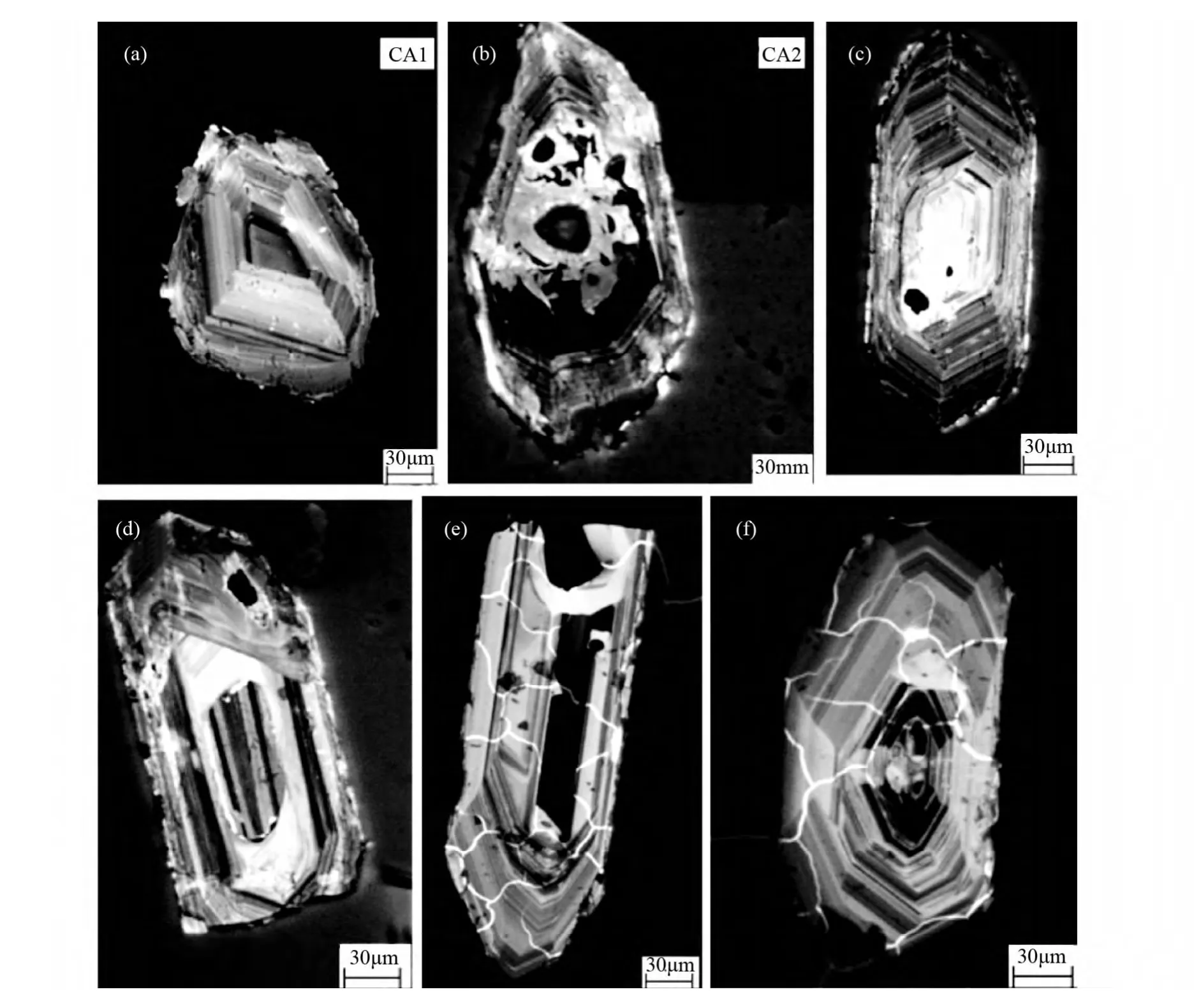
Fig.3 Cathodoluminescence (CL)images of zircons extracted from granitic gneisses,the Pütürge massif(a)oscilatory zoned zircon (sample dk704);(b)oscilatory zoned zircon with inner patches (sample ch308);(c)oscilatory zoned zircon with small patch in its mantle (sample dk704);(d)oscilatory zoned zircon with small patch in its inner rim (sample dk704);(e,f)zircons with cracks(sample ch308)
Some zircon grains exhibit dark CL colour,unzoned cores and light color in the primary rims (Fig.3e)while others show contrary phenomenon.This is the result that Si or high amounts of U,Th and Y replacing Zr in the light CL color areas (Xu et al.,2012;Cherniak and Watson,2001;Cherniak et al.,1997;Bebout,2007;Kooijman et al.,2009).Different coloration on the rim and inner parts of the zircon grains may be due to the distribution of the inclusion minerals preserved in the zircons,or the lack of fluid during the dehydration process of hydrous phases such as chlorite,muscovite and biotite during the prograde metamorphism (Kooijman et al.,2011;Ewing,1994).In CL images,the inclusions of U-rich minerals,such as xenotime,thorite and coffinite were observed.This is especially verified by the fact that the U-rich mineral is the result of the CL color change between the cores and rims of some zircons.Welldeveloped,regular zoning and prismatic zircon grains indicate magmatic origin of the zircons.Unzoned zircons with partially distinct core dimensions may have resulted from fluid-related mineral reactions possibly occurred at the metamorphic peak(Möller et al.,2003;Nasdala et al.,2001,2004).The element difference may be due to either approaching of the fluid to the crystal lattice or inclusion minerals and thus affects luminescence property (Xu et al., 2012; Hoskin and Schaltegger,2003).Moreover,porous and screen core types are seen in both rock samples.According to Xu et al.(2012)and Pan (1997),porous structure and cracks that represent the first stage of radiation damage speed up the metamictization process.Even though the protolith is identical,the texture type of the zircons may be different.Breaks in zircons with subhedral radial cracks stretch vertically to the rims of the zircon grains (Fig.3e,f).Such breaks may cause increasing radiation damage.

Table2 U-Pb isotopic data of zircons of metagranite, the Pütürge metamorphic massif(CA1 in sampl edk704)
5.2 U and Th concentrations of the zircons
Chemical components of the zoned and unzoned cores of the zircon grains are different.U content of the cores of the zoned zircon grains is less than that of the unzoned cores (Table 2).However,Th content is partially greater in the unzoned cores.The Th/U ratio in the zoned cores is greater than that of the unzoned cores.Zircons with higher U content and lower Th content indicate metamorphic origin whereas those with relatively higher Th and lower U content indicate magmatic zircons(Hoskin and Schaltegger,2003;Schaltegger et al.,1999;Wiedenbeck et al.,1995;Geisler et al.,2002;Griffin et al.,2007).It has been determined that the Th/U ratio of the zircon is 1.38 for the unzoned core and 1.92 for the zoned core (CA1 in sample dk704),well within the Th/U range (6~0.05)of magmatic zircons (Hoskin and Schaltegger,2003).Some portion of the zircons has undergone radiation damage and their U content has increased whereas the other samples are magmatic crystals that preserve their primary zoning properties.
5.3 Trace element chemistry
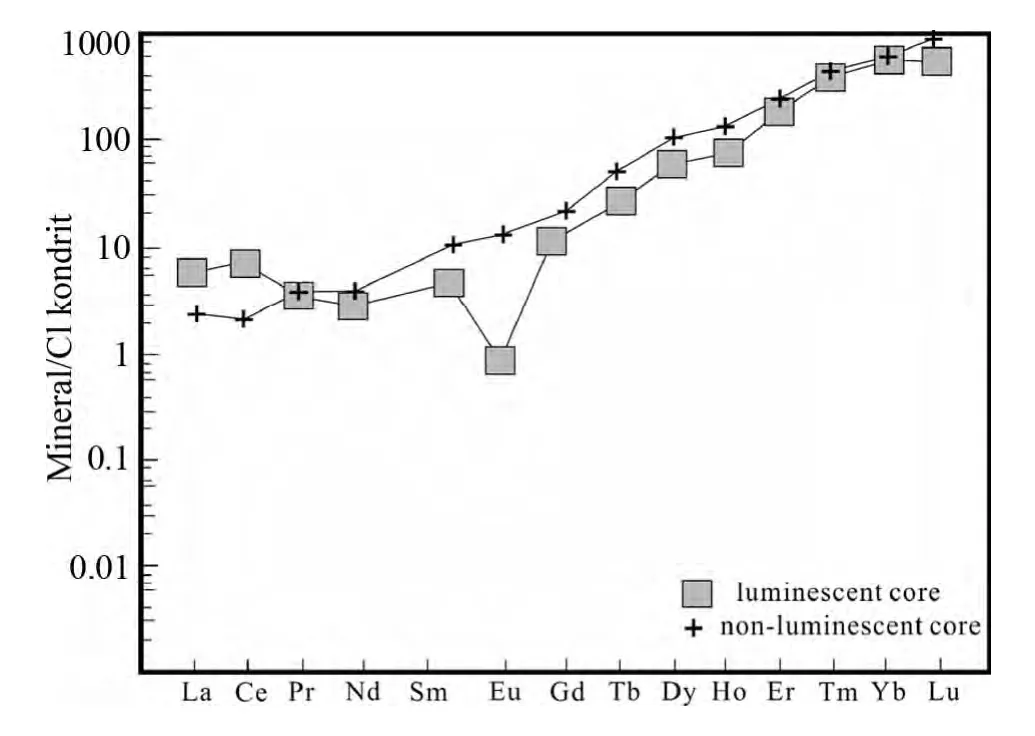
Fig.4 Chondrite-normalized REE diagrams showing the REE content of luminescent core and non-luminescent core of a zircon extracted from a metagranite (sample YK43.4.1),the Pütürge Massif
The REE ((Lu/Gd)N=7-32)contents of the zircons are present in a wider range with more luminescent cores and negative Eu anomaly and slightly positive Ce anomaly are observed(Fig.4).On the contrary,the core with weak luminescence (CA1 in sample dk704)has more REE ((Lu/Gd)N=15-25)anomaly and the REE change in a narrower interval.The weak luminescent core is possibly the product of prograde dehydration reaction during regional metamorphism (Kooijman et al.,2011;Mattinson,2005).Temperature,fluid and melts may affect the extent of the damage.The different structural patterns of the same protolith at the same temperature conditions are interpreted as the diversity of the variables that cause radiation.
5.4 SIMS U-Pb age of the zircons
Zircons suitable for U-Pb dating separated from metagranite sample dk704,are euhedral or subhedral and have a prismatic appearance.Zircon sizes vary from a few millimeters to 1cm in length and show grey color.Oscillatory zoning of the zircons is observed in the CL images,indicative of magmatic origin.
The SIMS U-Pb analytical data of the zircons (sample dk704)are listed in Table 2.The concordia age of these analytical spots is averaged to be 84.2 ±1.1Ma,interpreted as the formation age of the protolith of the gneiss,dated to be in the Cretaceous Santonian (Fig.5).
6 39Ar/40Ar dating of metamorphic biotites
The40Ar/39Ar age of biotite separated from a metapelitic biotite-schist (sample dk173.8)from gradual heating,are given in Table 3.The schist consists mainly of biotite,quartz,muscovite,chlorite, plagioclase, garnet, kyanite, apatite,sphene and opaque minerals.The garnet schist displays porphyroblastic,granolepidoblastic or lepidogranoblastic texture.Biotite is the most abundant mineral.It is found that in some such rocks chlorite or quartz is more abundant than biotite.Chlorite might be formed at the expanse of biotite from regressive metamorphism.Biotites with long prismatic crystals display a regular alignment parallel to the schistosity.
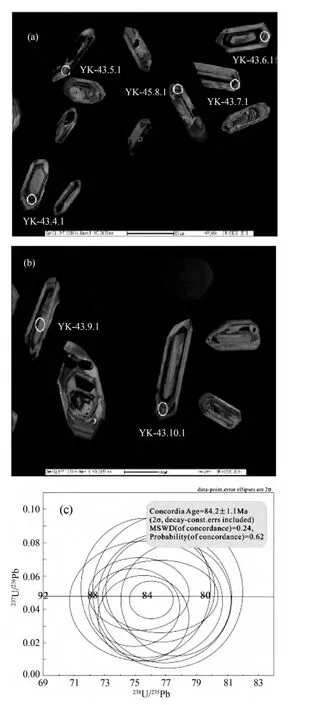
Fig.5 CL imagines of the analytized magmatic zircons and U-Pb age plotted on the concordia diagram (sample dk704),the Pütürge massif

Table3 40Ar/39Ar isotopic data of the metapelitic biotites(sampledk173.8) of the Pütürge metamorphic massi
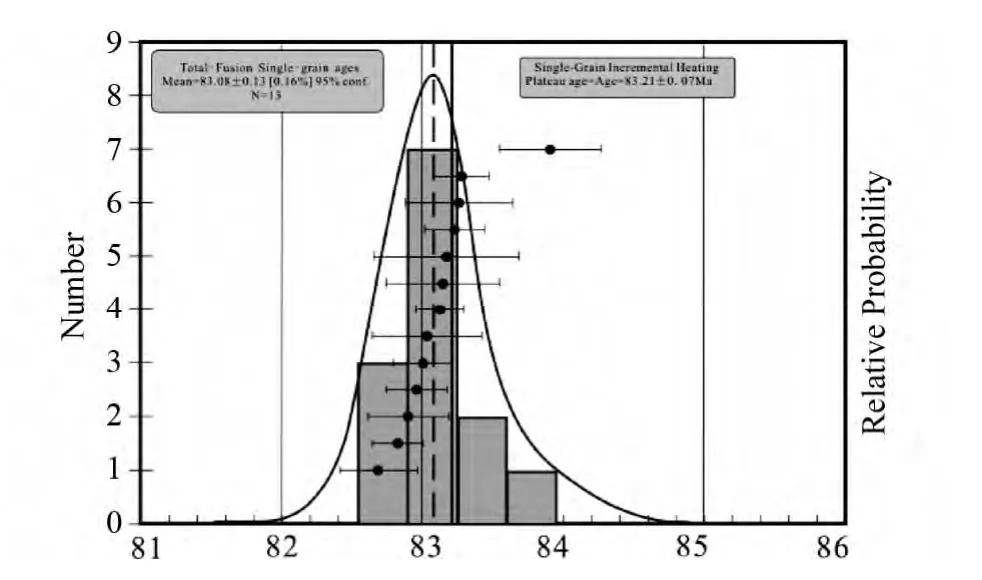
Fig.6 40Ar/39Ar age spectra of the biotites extracted from a mica schist (sample dk173.8),the Pütürge Massif
A perfect plateau has been defined on the analyzed biotite(sample dk173.8).The resulting plateau age and the40Ar/39Ar isochron age are indistinguishable and the age is determined to be 83.21 ±0.069Ma (Fig.6).The standard deviation of the determined ages is on the 2σ confidence level.This age records a period of metamorphism of the rocks cooled down to below~300℃(Ateş,2011).
7 Discussion and conclusion
The 83.21 ±0.069Ma plateau age of a mica schist (sample dk173.8)of the Pütürge massif was determined via biotite40Ar/39Ar geochronologic method (Ateş,2011).Similar ages have been obtained for the same belt by Rolland et al.(2011)and Oberhänsli et al.(2010).Rolland et al.(2012)have used the40Ar/39Ar age method and determined the age of 0.7 ±0.3Ma for the phengites of the mica schists.The K-Ar age of the Guleman ophiolite located on the further east of the study area was determined to be 72.4 ± 1.8Ma (Kılıç,2009).The settlement age of the Maden volcanic belt located on the Pütürge massif was determined as 79~80Ma,and the 74~71Ma age of Bitlis-Pütürge high pressure metamorphism was gained(Oberhansli et al.,2010).In summary,it was concluded that the first effective period of the metamorphism of the massif was the Alpine metamorphic episode (Yazgan and Chessex,1991)and this metamorphism should have occurred during the Campanian period due to the obduction of the ophiolites.Simultaneously,the SHRIMP U-Pb data (84.2 ± 1.1Ma)carried out on the zircons of the granitic gneiss,is interpreted to be the formation age of the protoliths.The metamorphic ages of the metamorphic rocks,point to Late Cretaceous Santonian.Previous studies carried out on the related units indicate either Coniacian-Santonian (Yazgan,1984),or Santonian-Maastrichtian (Aktaş and Robertson,1984),or Coniacian-Early Maastrichtian (Bingöl,1988)or Coniacian-Early Campanian(Yazgan and Chessex,1991)age intervals.The geochronologic data of this contribution and field observations indicate that the Pütürge metamorphic rocks suffered metamorphism immediately after the obduction of the ophiolite,prior to the Arabia-Eurasia Plates collision and the closure of the southern branch of Neotetis.Metamorphism of the Pütürge massif over the Arabian continental block,might started immediately after formation of the massif.It is also probable that metamorphism of the Late Cretaceous-Santonian may be a Barrovian-type regional metamorphism,from green schist to upper amphibolite facies.Retrograde metamorphism may be due to uplift of the Pütürge metamorphic rocks.CL images of the zircons of the metamorphic rocks suggest that the core is rich in uranium.The porous texture and cracks comprise the first stage of radiation damage of zircon rims and led to partial metamictization.Fluid may be also responsible to the radiation damage process of the zircon and altered the Th/U ratio.
Aktaş G and Robertson AHF.1984.Maden complex,SE Turkey:Evolution of a Neotethyan active margin.Geological Society of London Special Publications,17(1):375-402
Ateş C.2011.Metamorfik kayaçlardaki zirkon mineralinin kristal yapısı ve metamorfizma koşullarının etkisi:Pütürge Metamorfiti Örnegi.F.ü.Fenbilimleri Enstitüsü Yüksek Lisans Tezi,88 (in Turkish)
Barker AJ.1990.Introduction to Metamorphic Textures and Microstructures.New York:Chapman and Hall,170
Bebout GE.2007.Metamorphic chemical geodynamics of subduction zones.Earth and Planetary Science Letters,260(3-4):373-393
Cherniak DJ,Hanchar JM and Watson EB.1997.Diffusion of tetravalent cations in zircon.Contributions to Mineralogy and Petrology,127(4):383-390
Cherniak DJ and Watson EB.2001.Pb diffusion in zircon.Chemical Geology,172(1-2):5-24
Erdem E.1994.Petrographic and petrological characteristic of Pütürge metamorphic rocks.Doctorate Dissertation,119 (in Turkish)
Ewing RC.1994.The metamict state:1993-The centennial.Nuclear Instruments and Methods in Physics Research,B91(1-4):22-29
Geisler T and Schleicher H.2000.Improved U-Th-total Pbdating of zircons by electron microprobe using a simple new background modeling procedure and Ca as a chemical criterion of fluid-induced U-Th-Pb discordance in zircon.Chemical Geology,163(1- 4):269-285
Geisler T,Pidgeon RT,van Bronswijk W and Kurtz R.2002.Transport of uranium,thorium,and lead in metamict zircon under low temperature hydrothermal conditions.Chemical Geology,191(1-3):141-154
Geisler T,Rashwan AA,Rahn M,Poller U,Zwingmann H,Pidgeon RT,Scleicher H and Tomaschek F.2003.Low-temperature hydrothermal alteration of natural metamict zircons from the Eastern Desert,Egypt.Mineralogical Magazine,67(3):485-508
Geisler T,Schaltegger U and Tomaschek F.2007.Re-equilibration of zircon in aqueous fluids and melts.Elements,3(1):43-50
Göncüoglu MC and Turhan N.1984.Geology of the Bitlis metamorphic belt.In:Tekeli O and Göncüoglu (eds.).Geology of the Taurus Belt.Ankara:MTA Institute,237-244
Griffin WL,Pearson NJ,Belousova EA and Saeed A.2007.Reply to“ Comment to short-communication ‘ Comment: Hf-isotope heterogeneity in zircon 91500’ by Griffin WL,Pearson NJ,Belousova EA,Saeed A (Chemical Geology 233 (2006)358-363)”by Corfu F.Chemical Geology,244(1-2):354-356
Hall R.1976.Ophiolite emplacement and the evolution of the Taurus suture zone,southeastern Turkey.Geological Society of America Bulletin,87(7):1078-1088
Hempton MR.1984.Results of detailed mapping near leak Hazar(Eastern Taurus Mountains).In:Geology of the Taurus Belt.Ankara:Int Symp Proc Maden Tetkik ve Arama Enstitüsü,223-228
Hoskin PWO and Black LP.2000.Metamorphic zircon formation by solid state recrystallization of protolith igneous zircon.Journal of Metamorphic Geology,18(4):423-439
Hoskin PWO and Schaltegger U.2003.The composition of zircon and igneous and metamorphic petrogenesis.Reviews in Mineralogy and Geochemistry,53(1):27-62
Kılıç AD.2009.Magma odası dinamiginin Guleman ofiyoliti açısından incelenmesi.FüBAP-1538 nolu münferit proje (in Turkish)
Kooijman E,Mezger K and Berndt J.2009.New constraints on Pb diffusion and closure temperature in rutile from in situ U-Pb dating by LA-ICP-MS.Geochimica et Cosmochimica Acta,73:681
Kooijman E,Upadhyay D,Mezger K,Raith MM,Berndt J and Srikantappa C.2011.Response of the U-Pb chronometer and trace elements in zircon to ultrahigh-temperature metamorphism:The Kadavur anorthosite complex,southern India.Chemical Geology,290(3-4):177-188
Mattinson JM.2005.Zircon U-Pb chemical abrasion(“CA-TIMS”)method:Combined annealing and multi-step partial dissolution analysis for improved precision and accuracy of zircon ages.Chemical Geology,220(1-2):47-66
Möller A,O’Brien PJ,Kennedy A and Kröner A.2003.Linking growth episodes of zircon and metamorphic textures to zircon chemistry:An example from the ultrahigh-temperature granulites of Rogaland (SW Norway).Geological Society,London,Special Publications,220(1):65-81
Nasdala L,Wenzel M,Vavra G,Irner G,Wenzel T and Kober B.2001.Metamictisation of natural zircon:Accumulation versus thermal annealing of radioactivity-induced damage.Contributions to Mineralogy and Petrology,141(2):125-144
Nasdala L,Reiners PW,Garver JI,Kennedy AK,Stern RA,Balan E and Wirth R.2004.Incomplete retention of radiation damage in zircon from Sri Lanka.American Mineralogist,89(1):219-231
Oberhänsli R,Candan O and Wilke F.2010.Geochronological evidence of Pan-African eclogites from the Central Menderes Massif,Turkey.Turkish Journal of Earth Sciences,19(4):431-447
Özkaya I.1982.Upper Cretaceous plate rupture and development of leaky transcurrent fault ophioites in SE Turkey.Tectonophysics,88(1-2):103-116
Pan Y.1997.Zircon- and monazite-forming metamorphic reactions at Manitouwadge,Ontario.Canadian Mineralogist,35:105-118
Ricoue LE,Marcoux J and Whitechurch H.1984.The Mesozoic organization of the Taurides:One or several ocean basins.Geological Society,London,Special Publications,17(1):349-359
Robertson AHF and Dixon JE.1984.Introduction:Aspects of the geological evolution of the Eastern Mediterranean.Geological Society,London,Special Publications,17(1):1-74
Rolland Y,Perinçek D,Kaymakcı N,Sosson M,Barrier E and Avagyan A.2012.Evidence for ca.80~75Ma subduction jump during Anatolide-Tauride-Armenian block accretion and~48Ma Arabia-Eurasia collision in Lesser Caucasus-East Anatolia.Journal of Geodynamics,56-57:76-85
Schaltegger U,Fanning CM,Günther D,Maurin JC,Schulmann K and Gebauer D.1999.Growth,annealing and recrystallization of zircon and preservation of monazite in high-grade metamorphism:Conventional and in-situ U-Pb isotope,cathodoluminescence and microchemical evidence.Contributions to Mineralogy and Petrology,134(2-3):186-201
Şengör AMC and Yilmaz Y.1981.Tethyan evolution of Turkey:A plate tectonic approach.Tectonophysics,75(3-4):181-190,193-199,203-241
Vavra G,Schmid R and Gebauer D.1999.Internal morphology,habit and U-Th-Pb microanalysis of amphibolite-to-granulite facies zircons:Geochronology of the Ivrea Zone (Southern Alps).Contributions to Mineralogy and Petrology,134(4):380-404
Wiedenbeck M,Alle P,Corfu F,Griffin WL,Meier M,Oberli F,von Quadt A,Roddick JC and Spiegel W.1995.Three natural zircon standards for U-Th-Pb,Lu-Hf,trace element and REE analyses.Geostandards Newsletter,19(1):1-23
Xu XS,Zhang M,Zhu KY,Chen XM and He ZY.2012.Reverse age zonation of zircon formed by metamictisation and hydrothermal fluid leaching.Lithos,150:256-267
Yazgan E and Cnessex R.1991.Geology and tectonic evolution of the southeastern Taurides in the region of Malatya.Turkish Association of Petroleum Geologists,3(1):1-41
Yazgan E.1984.Geodynamic evolution of the Eastern Taurus region:Geology of the Taurus belt.In:Geology of the Taurus Belt:Proceedings of the International Symposium.Ankara:Geology of the Taurus Belt,199-208
Yilmaz Y.1993.New evidence and model on the evolution of the Southeast Anatolian orogen.Geological Society of America Bulletin,105(2):251-271

